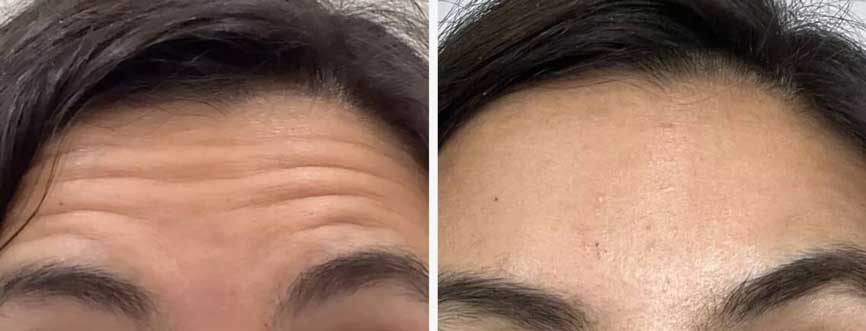Botox treatment for Horizontal Forehead Lines - Dr Yeung Ho Hong 楊浩康

Forehead wrinkles, also known as frown lines, are fine lines that many people unintentionally develop through daily facial expressions. These wrinkles are primarily caused by the repeated use of the frontalis muscle. As age increases, skin elasticity decreases, and long-term expression habits take their toll, these wrinkles gradually deepen and become more noticeable. To address this issue, botulinum toxin injections have become a highly popular non-surgical cosmetic treatment. The goal is to temporarily relax the frontalis muscle, smoothing out wrinkles and restoring a youthful appearance.
In the treatment process, an experienced physician will precisely inject botulinum toxininto multiple areas of the forehead based on the patient’s wrinkle distribution. The core concept of the treatment is to reduce the frequency of excessive frontalis muscle contractions, thereby weakening the muscle’s tendency to pull the skin and form wrinkles. Typically, the procedure takes only a few minutes, involves minimal discomfort, and requires no sedation or general anesthesia. This makes it an ideal option for busy professionals and individuals seeking minimally invasive cosmetic solutions.
It’s worth noting that due to differences in skin thickness and muscle structure between genders, men generally require higher doses of botulinum toxin to achieve the same results as women. Men tend to have more developed frontalis muscles, making adjustments to dosage and injection sites particularly critical. A skilled physician will tailor the injection plan to each patient’s unique physique and facial features, ensuring natural results without compromising everyday expressions.
At the same time, while botulinum toxin injections are highly effective, they do come with potential side effects. For instance, uneven injections or improper dosing may lead to drooping eyebrows or facial asymmetry in some patients. Additionally, if insufficient botulinum toxin is administered to the outer portions of the frontalis muscle, it could result in an unnatural lifting of the outer eyebrows, creating an odd facial expression. These risks underscore the importance of selecting a highly skilled and reputable medical professional and undergoing a thorough pre-treatment evaluation and risk discussion.
Prior to treatment, the physician will typically discuss the patient’s facial structure, wrinkle condition, and treatment expectations in detail to determine the optimal injection points and dosage. Before starting, local cleansing and disinfection are standard procedures, which not only help alleviate the patient’s fear of injections but also effectively prevent infections or other complications. Post-treatment, physicians usually provide a set of care instructions, advising patients to avoid massaging the injection sites for several hours, refrain from strenuous exercise, and steer clear of high-temperature environments to ensure the toxin effectively targets the intended muscles.
The recovery phase after the procedure is also crucial. Most patients notice a reduction in wrinkles within a few days of the injection, with optimal results typically appearing one to two weeks post-treatment. Over time, the effects of botulinum toxin gradually wear off, and patients may require periodic maintenance treatments to sustain a youthful, smooth facial appearance. Through such cyclical treatments, many individuals successfully delay aging signs caused by excessive muscle activity, significantly boosting their confidence and outward appearance.
In summary, botulinum toxin injection is a well-established and widely favored anti-aging technique, particularly suitable for those concerned about forehead wrinkles. With precise injections, personalized dosing, and professional post-treatment care, this method effectively reduces wrinkles caused by muscle movement, resulting in a more natural and softened facial expression. However, as each patient’s skin condition and muscle structure vary, thorough communication with a professional physician before treatment and strict adherence to post-treatment advice are essential to achieving ideal and safe outcomes. With ongoing advancements in technology, the future of facial anti-aging treatments promises even more innovative options, offering greater choices for those pursuing a youthful appearance.
